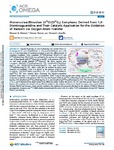Mostrar o rexistro simple do ítem
Mononuclear/Binuclear [VIVO]/[VVO2] Complexes Derived from 1,3-Diaminoguanidine and Their Catalytic Application for the Oxidation of Benzoin via Oxygen Atom Transfer
| dc.contributor.author | Maurya, Mannar | |
| dc.contributor.author | Kumar, Naveen | |
| dc.contributor.author | Avecilla, Fernando | |
| dc.date.accessioned | 2023-03-21T19:00:38Z | |
| dc.date.available | 2023-03-21T19:00:38Z | |
| dc.date.issued | 2023-01-10 | |
| dc.identifier.citation | Mannar R. Maurya, Naveen Kumar, and Fernando Avecilla (2023). Mononuclear/Binuclear [VIVO]/[VVO2] Complexes Derived from 1,3-Diaminoguanidine and Their Catalytic Application for the Oxidation of Benzoin via Oxygen Atom Transfer. ACS Omega, 8 (1), 1301-1318. DOI: 10.1021/acsomega.2c06732 | es_ES |
| dc.identifier.issn | 2470-1343 | |
| dc.identifier.uri | http://hdl.handle.net/2183/32727 | |
| dc.description.abstract | [Abstract] Ligands H4sal-dag (I) and H4Brsal-dag (II) derived from 1,3-diaminoguanidine and salicylaldehyde or 5-bromosalicylaldehyde react with one or 2 mol equivalent of vanadium precursor to give two different series of vanadium complexes. Thus, complexes [VIVO(H2sal-dag) (H2O)] (1) and [VIVO(H2Brsal-dag) (H2O)] (2) were isolated by the reaction of an equimolar ratio of these ligands with [VIVO(acac)2] in MeOH. In the presence of K+/Cs+ ion and using aerially oxidized [VIVO(acac)2], the above reaction gave complexes [K(H2O){VVO2(H2sal-dag)}]2 (3), [Cs(H2O){VVO2(H2sal-dag)}]2 (4), [K(H2O){VO2(H2Brsal-dag)}]2 (5), and [Cs(H2O){VVO2(H2Brsal-dag)}]2 (6), which could also be isolated by direct aerial oxidation of complexes 1 and 2 in MeOH in the presence of K+/Cs+ ion. Complexes [(H2O)VIVO(Hsal-dag)VVO2] (7) and [(H2O)VIVO(HBrsal-dag)VVO2] (8) were isolated upon increasing the ligand-to-vanadium precursor molar ratio to 1:2 under an air atmosphere. When I and II were reacted with aerially oxidized [VIVO(acac)2] in a 1:2 molar ratio in MeOH in the presence of K+/Cs+ ion, they formed [K(H2O)5{(VVO2)2(Hsal-dag)}]2 (9), [Cs(H2O)2{(VVO2)2(Hsal-dag)}]2 (10), [K2(H2O)4{(VVO2)2(Brsal-dag)}]2 (11), and [Cs2(H2O)4{(VVO2)2(Brsal-dag)}]2 (12). The structures of complexes 3, 4, 5, and 9 determined by single-crystal X-ray diffraction study confirm the mono-, bi-, tri-, and tetra-anionic behaviors of the ligands. All complexes were found to be an effective catalyst for the oxidation of benzoin to benzil via oxygen atom transfer (OAT) between DMSO and benzoin. Under aerobic condition, this oxidation also proceeds effectively in the absence of DMSO. Electron paramagnetic resonance and 51V NMR studies demonstrated the active role of a stable V(IV) intermediate during OAT between DMSO and benzoin. | es_ES |
| dc.description.sponsorship | M.R.M. thanks the Science and Engineering Research Board (SERB), Department of Science and Technology, New Delhi, India for the financial support (grant no. CRG/2018/000182) | es_ES |
| dc.description.sponsorship | Government of India. Science and Engineering Research Board; CRG/2018/000182 | es_ES |
| dc.language.iso | eng | es_ES |
| dc.publisher | ACS | es_ES |
| dc.relation.uri | https://doi.org/10.1021/acsomega.2c06732 | es_ES |
| dc.rights | Atribución-NoComercial-CompartirIgual 4.0 Internacional | es_ES |
| dc.rights.uri | http://creativecommons.org/licenses/by-nc-sa/4.0/ | * |
| dc.subject | Aromatic compounds | es_ES |
| dc.subject | Ethanol | es_ES |
| dc.subject | Ligands | es_ES |
| dc.subject | Oxidation | es_ES |
| dc.subject | Vanadium | es_ES |
| dc.title | Mononuclear/Binuclear [VIVO]/[VVO2] Complexes Derived from 1,3-Diaminoguanidine and Their Catalytic Application for the Oxidation of Benzoin via Oxygen Atom Transfer | es_ES |
| dc.type | info:eu-repo/semantics/article | es_ES |
| dc.rights.access | info:eu-repo/semantics/openAccess | es_ES |
| UDC.journalTitle | ACS Omega | es_ES |
| UDC.volume | 8 (2023) | es_ES |
| UDC.issue | 1 | es_ES |
| UDC.startPage | 1301 | es_ES |
| UDC.endPage | 1318 | es_ES |
| dc.identifier.doi | 10.1021/acsomega.2c06732 |






